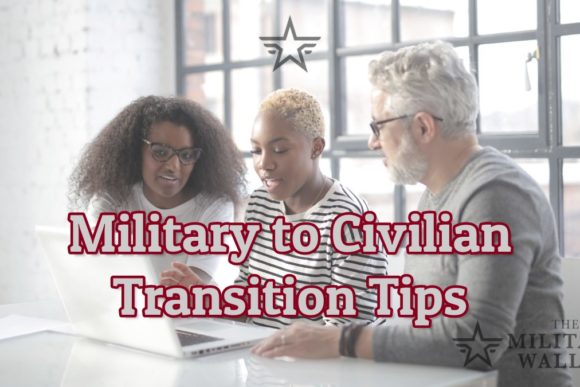Disclosure: This article is sponsored by Navy Mutual.
Transitioning from the military to civilian life is a huge life change that involves critical financial considerations. We’ve put together a list of financial recommendations for you to take into account prior to separating.
1. Put Together a Transition Fund.
Whether or not you have a job lined up after you leave the military, it’s a good idea, if possible, to set up a fund with enough money to cover at least six months of your expenses. Take the time to add up how much you spend on average in a month. Keep in mind that leaving the military will likely mean additional expenses to take into consideration. For example, once you separate you will no longer receive Basic Allowance for Housing (BAH) and will need to cover your own housing expenses.
Even if you are not able to save six months’ worth, remember that having some savings is better than none. Civilian careers often have less stability than the military; having a transition fund will provide you with better financial security as you embark into this next chapter of your life.
2. Know Your Future Tax Situation.
As a civilian, you will be expected to file and pay your federal taxes by April 15th; state tax rates and regulations vary significantly. Familiarize yourself with the tax rate in the state where you will reside after leaving the military to avoid unpleasant surprises when you next file. If you’re retiring from the military, know that there are multiple states that don’t tax military retirement income.
3. Learn Your Coverage Options
The military makes it easy for you to get certain types of insurance. However, you may not be eligible for those insurance policies when you leave the military. Here are three coverage areas to pay attention to when you transition.
Health insurance
Health insurance is critical. If you have a civilian job lined up already, make sure to understand all benefits offered and the employee’s share of any premium cost associated with different benefit levels. If you are retiring from the military after 20 years of active duty service, you are eligible for insurance through TRICARE. If you are separating but not retiring, you may qualify for temporary coverage through the Continued Health Care Benefit Program. TRICARE’s website has more information on temporary coverage here.
Some veterans may be eligible for VA health care; click here for eligibility information. You can also check your state’s healthcare market place to see what options they offer. Be sure to factor any health insurance costs into your new expenses for budgeting purposes. A medical issue without health insurance could drastically hurt your financial situation, so be sure you are covered when you separate.
Life insurance
Life insurance is key to the strength of your family’s financial future and stability. After 120 days from the end of active service, you will no longer have access to $400,000 worth of life insurance coverage from Servicemember’s Group Life Insurance (SGLI).
You can apply for Veterans’ Group Life Insurance (VGLI) up to 240 days after leaving the service without a medical exam. Keep in mind, though, that because no medical exam is required, premiums for VGLI may be higher than necessary for a person who is in average or better health. You may be better off choosing a life insurance policy through another provider.
To learn more about the differences between VGLI and individual Level Term, download our life insurance guide.
SBP
The Survivor Benefit Plan (SBP) is a government-backed, monthly income annuity provided to enrolled beneficiaries when a servicemember dies. Military retirees forego a small (6.5%) pre-tax percentage of monthly pension income to protect up to 55% of their pension benefit that may receive a Cost of Living Adjustment (COLA) for a survivor’s entire lifetime. SBP offers a very subsidized way to preserve part of that monthly income for an eligible beneficiary.
While on active duty, SBP is a free automatic benefit of service, but participation for a retiree’s beneficiary is a voluntary decision that should not be taken lightly since the election in most circumstances is irreversible. Retirees are required to make an SBP election by their last day on active duty or are otherwise enrolled at the maximum possible SBP protection level, so confirm with your administrative office when your paperwork should be submitted. The SBP election is made on form DD-2656, or CG4700 for USCG, National Oceanic and Atmospheric Administration, and USPHS.
You may elect SBP based on your gross retired pay or a smaller base amount (from $300/month to full retired pay). If you elect SBP, you must designate your beneficiary at that time. Visit this link for useful calculators and more information on the SBP.
4. Consider Your Retirement Plan.
Do you contribute to a Thrift Savings Plan (TSP)?
Carefully consider whether or not to roll over the account into an IRA or 401K. Investment management fees in a TSP account are much lower than any other retirement account alternative, meaning you would be spending less to keep the money there than in a different account, resulting in greater potential growth over many years.
Remember that once you leave the military you will not be able to open another TSP account if you close your existing account (unless you are employed by the federal government). While you can no longer make regular contributions to your TSP after you separate, you may be able to rollover other qualified retirement accounts to reduce administration fees for more of your retirement savings.
Speak with a financial planner familiar with TSP and military retirement prior to making any significant changes to your TSP account.
5. Understand your veteran benefits.
The VA has numerous resources and benefits for veterans that you may be eligible for. Find out more information by using the links below:
- Post 9/11 GI Bill
- VA Vocational Rehabilitation and Employment
- Free educational and career counseling
- Disability
- Housing assistance
- Veterans Crisis Line
Additionally, Navy Mutual is the nation’s oldest federally recognized Veteran Service Organization (VSO), to learn more about the veteran services we provide, visit our veteran services center.




About the comments on this site:
These responses are not provided or commissioned by the bank advertiser. Responses have not been reviewed, approved or otherwise endorsed by the bank advertiser. It is not the bank advertiser’s responsibility to ensure all posts and/or questions are answered.